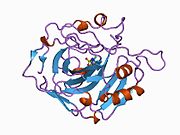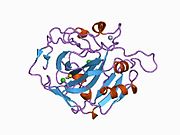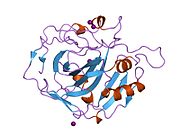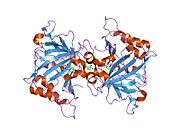
Red blood cells (RBCs), referred to as erythrocytes in academia and medical publishing, also known as red cells, erythroid cells, and rarely haematids, are the most common type of blood cell and the vertebrate's principal means of delivering oxygen to the body tissues—via blood flow through the circulatory system. Erythrocytes take up oxygen in the lungs, or in fish the gills, and release it into tissues while squeezing through the body's capillaries.

Acetazolamide, sold under the trade name Diamox among others, is a medication used to treat glaucoma, epilepsy, acute mountain sickness, periodic paralysis, idiopathic intracranial hypertension, heart failure and to alkalinize urine. It may be used long term for the treatment of open angle glaucoma and short term for acute angle closure glaucoma until surgery can be carried out. It is taken by mouth or injection into a vein. Acetazolamide is a first generation carbonic anhydrase inhibitor and it decreases the ocular fluid and osmolality in the eye to decrease intraocular pressure.
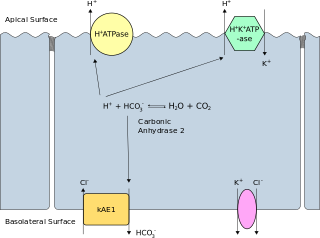
Band 3 anion transport protein, also known as anion exchanger 1 (AE1) or band 3 or solute carrier family 4 member 1 (SLC4A1), is a protein that is encoded by the SLC4A1 gene in humans.
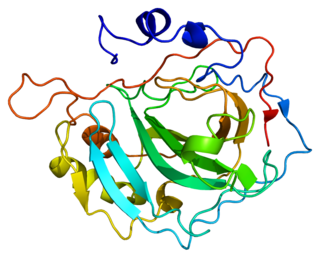
Carbonic anhydrase II is one of sixteen forms of human α carbonic anhydrases. Carbonic anhydrase catalyzes reversible hydration of carbon dioxide. Defects in this enzyme are associated with osteopetrosis and renal tubular acidosis. Renal carbonic anhydrase allows the reabsorption of bicarbonate ions in the proximal tubule. Loss of carbonic anhydrase activity in bones impairs the ability of osteoclasts to promote bone resorption, leading to osteopetrosis.
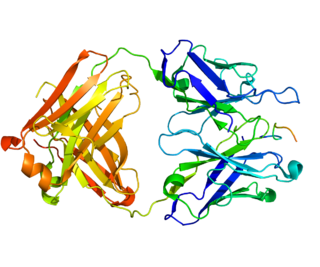
Carbonic anhydrase IX is an enzyme that in humans is encoded by the CA9 gene. It is one of the 14 carbonic anhydrase isoforms found in humans and is a transmembrane dimeric metalloenzyme with an extracellular active site that facilitates acid secretion in the gastrointestinal tract. CA IX is overexpressed in many types of cancer including clear cell renal cell carcinoma (RCC) as well as carcinomas of the cervix, breast and lung where it promotes tumor growth by enhancing tumor acidosis.

Electrogenic sodium bicarbonate cotransporter 1, sodium bicarbonate cotransporter is a membrane transport protein that in humans is encoded by the SLC4A4 gene.

Anion exchange protein 2 (AE2) is a membrane transport protein that in humans is encoded by the SLC4A2 gene. AE2 is functionally similar to the Band 3 Cl−/HCO3− exchange protein.

Carbonic anhydrase 4 is an enzyme that in humans is encoded by the CA4 gene.

Carbonic anhydrase 12 is an enzyme that in humans is encoded by the CA12 gene.

Carbonic anhydrase-related protein 10 is an enzyme that in humans is encoded by the CA10 gene.

Carbonic anhydrase-related protein is a protein that in humans is encoded by the CA8 gene. The CA8 protein lacks the catalytic activity of other carbonic anhydrase enzymes. A rare, autosomal recessive form of cerebellar ataxia known as "cerebellar ataxia, mental retardation, and dysequilibrium syndrome 3" (CAMRQ3) is caused by mutations in the CA8 gene.
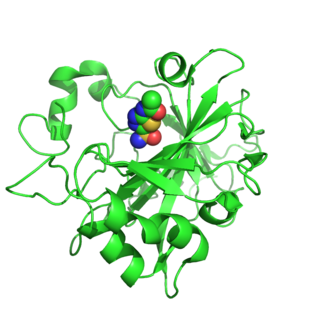
Carbonic anhydrase 14 is an enzyme that in humans is encoded by the CA14 gene.

Carbonic anhydrase 5B, mitochondrial is an enzyme that in humans is encoded by the CA5B gene.

Carbonic anhydrase 7 (CA7) is an enzyme that in humans is encoded by the CA7 gene.

Carbonic anhydrase-related protein 11 is a protein that in humans is encoded by the CA11 gene.

The carbonic anhydrases form a family of enzymes that catalyze the interconversion between carbon dioxide and water and the dissociated ions of carbonic acid. The active site of most carbonic anhydrases contains a zinc ion. They are therefore classified as metalloenzymes. The enzyme maintains acid-base balance and helps transport carbon dioxide.

Carbonic anhydrase 13 is a protein that in humans is encoded by the CA13 gene.

Carbonic anhydrase 5A, mitochondrial is a protein that in humans is encoded by the CA5A gene.
Carbonyl sulfide hydrolase (EC 3.13.1.7; abbreviated as COSase) is an enzyme that degrades carbonyl sulfide (COS) to hydrogen sulfide (H2S) and carbon dioxide (CO2). Isolated from Thiobacillus thioparus bacterium, the potential of COSase would reduce the high global warming effect of COS and change the ozone chemistry, because COS is the source of sulfur in the troposphere.

























